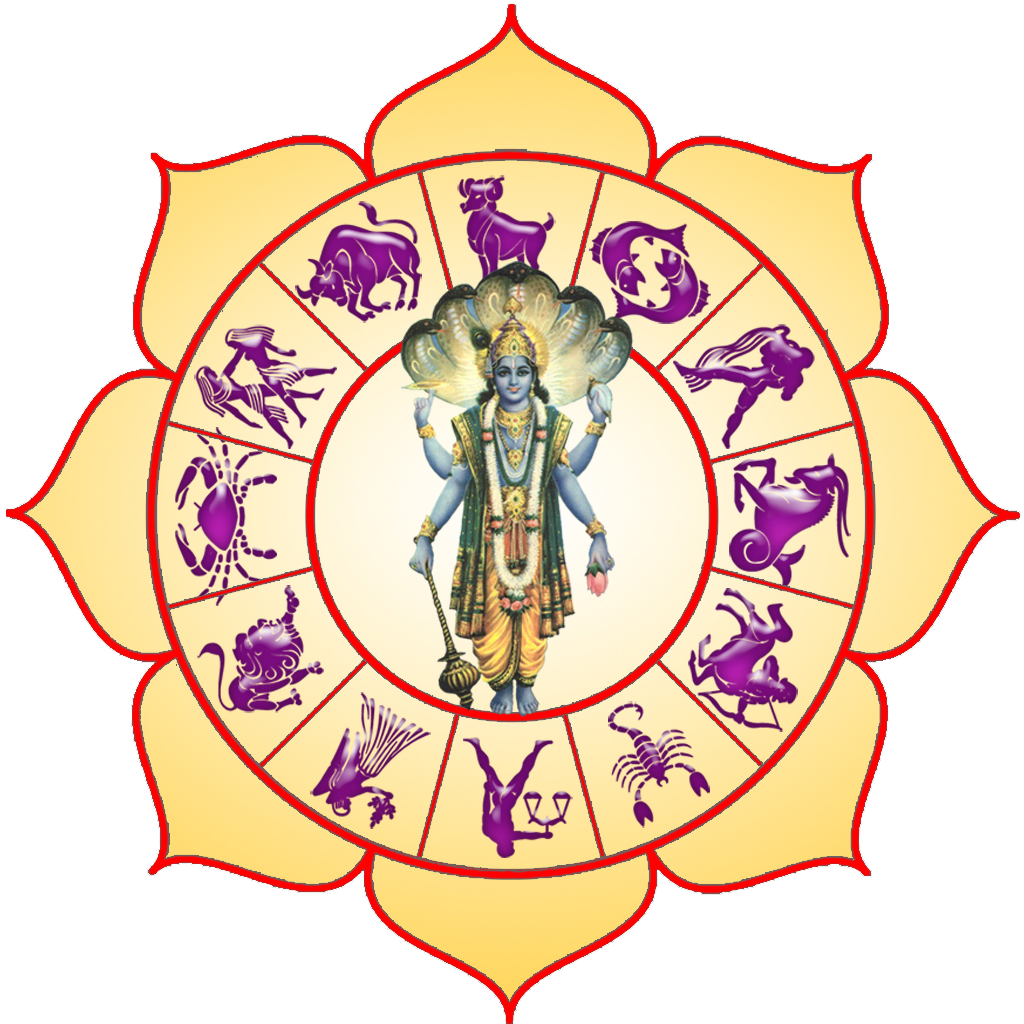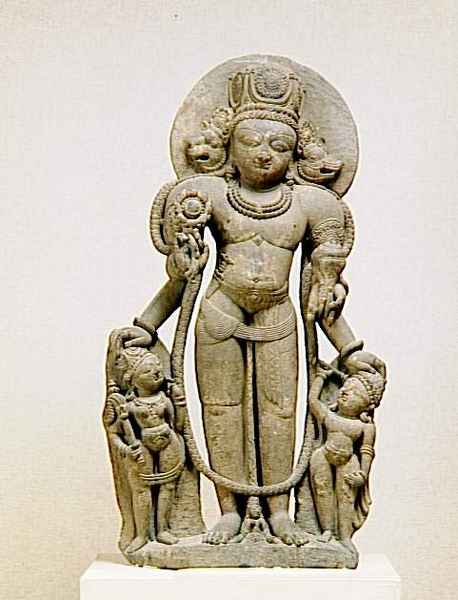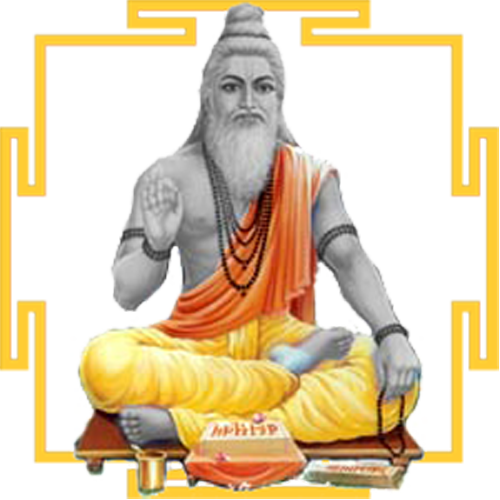rāśi-dṛṣṭi-kathana-adhyāyaḥ
अथ राशिदृष्टिकथनाध्यायः ॥ ९ ॥
Chapter 9 Aspects of The Signs:
अथ मेषादिराशीनां चरादीनां पृथक्-पृथक् ।
दृष्टिभेदं प्रवक्ष्यामि श्रृणु त्वं द्विजसत्तम ! ॥ १ ॥
राशयोऽभिमुखं विप्र ! तथा पश्यन्ति पार्श्वभे ।
यथा चरः स्थिरानेवं स्थिरः पश्यति वै चरान् ॥ २ ॥
द्विस्वभावो विनाऽऽत्मानं द्विस्वभावान् प्रपश्यति ।
समीपस्थं परित्यज्य खेटास्तत्र गतास्तथा ॥ ३ ॥
atha meṣādirāśīnāṁ carādīnāṁ pṛthak pṛthak .
dṛṣṭibhedaṁ pravakṣyāmi śṛṇu tvaṁ dvijasattama .. 1..
rāśayo’bhimukhaṁ vipra tathā paśyanti pārśvabhe .
yathā caraḥ sthirānevaṁ sthiraḥ paśyati vai carān .. 2..
dvisvabhāvo vinā’tmānāṁ dvisvabhāvān prapaśyati .
samīpasthaṁ parityajya kheṭāstatra gatāstathā .. 3..
Sharma:
O excellent of the Brahmins listen to me, now I would separately tell you about the aspects of the signs like Aries or movable signs etc. The signs aspect the signs opposite to them and both sides of them. As the movable signs aspect the fixed ones, so the fixed signs have their aspects on movable ones. A common sign aspects the other common signs except its own self. And the planets situated in these signs also aspect in the same manner, they leave out the planet situated in the adjacent sign.
चरेषु संस्थिताः खेटा: पश्यन्ति स्थिरसङ्गतान् ।
स्थिरेषु संस्थिता एवं पश्यन्ति चरसंस्थितान् ॥ ४ ॥
उभयस्थास्तु सूर्याद्याः पश्यन्त्युभयसंस्थितान् ।
निकटस्थं विना खेटा: पश्यन्तीत्ययमागमः ॥ ५ ॥
careṣu saṁsthitāḥ kheṭāḥ paśyanti sthirasaṅgatān .
sthireṣu saṁsthitā evaṁ paśyanti carasaṁsthitān .. 4..
ubhayasthāstu sūryādyā paśyanyubhayasaṁsthitān .
nikaṭasthaṁ vinā kheṭāḥ paśyantītyayamāgamaḥ .. 5..
Sharma:
Planets situated in movable signs aspect the other 3 fixed signs except the one adjacent to them, those situated in fixed ones aspect the other 3 movable signs except the one adjacent to them and, the planets Sun etc, situated in common or dual signs aspect the other 3 common or dual signs except the ones in which they are situated and they also aspect the planets situated in them.
दृष्टिचक्रमहं वक्ष्ये यथावद् ब्रह्मणोदितम् ।
यस्य विन्यासमात्रेण दृष्टिभेदः प्रकाश्यते ॥ ६ ॥
प्राचि मेषवृषौ लेख्यौ कर्कसिंहौ तथोत्तरे ।
तुलाऽली पश्चिमे विप्र ! मृगकुम्भौ च दक्षिणे ॥ ७ ॥
ईश-कोणे तु मिथुनं वायव्ये कन्यकां तथा ।
नैर्ऋत्यां चापमालिख्य वह्निकोणे झषं लिखेत् ॥ ८ ॥
एवं चतुर्भुजाकारं वृत्ताकारमथापि वा।
दृष्टिचक्रं प्रविन्यस्यैवं ततो दृष्टिं विचारयेत् ॥ ९ ॥
dṛṣṭicakramahaṁ vakṣye yayāvad brahmaṇoditam .
tasya vinyāsamātreṇa dṛṣṭibhedaḥ prakāśyate .. 6..
prāci mīṣavṛṣau lekhyau karkasiṁhau tathottare .
tulā’lī paścime vipra mṛgakumbhau ca dakṣiṇe .. 7..
īśakoṇe tu mithunaṁ vāyavye kanyakāṁ tathā .
naurṛrtyāṁ cāpamālikhya vahnikoṇe chaṣaṁ likhet .. 8..
evaṁ caturbhujākāraṁ vṛttākāramathāpi vā .
dṛṣṭicakraṁ pravinyasyaivaṁ tato dṛṣṭiṁ vicārayet .. 9..
Sharma:
Now I will narrate, as spoken by Lord Brahma, the aspectual diagram by the mere sight of which the various aspects of the planets are well illustrated. In a square or a circle are marked the eight directions (4 corners and 4 quarters there of) Then the Zodiacal signs are marked as under: Aries and Taurus in east, Gemini in the North East, Cancer and Leo in the North, Virgo in the North West, Libra and Scorpio in the West, Sagittarius in the South West, Capricorn and Aquarius in the South and, Pisces in the South East. It is in this way and after this that the Various aspects are to be considered :
होरा शास्त्रे भिन्न दृष्टिः खेटानां च परस्परम् ।
त्रिदेशे च त्रिकोणे च चतुरस्त्रे च सप्तमे ॥ १० ॥
horā śāstre bhinna dṛṣṭiḥ kheṭānāṃ ca parasparam |
trideśe ca trikoṇe ca caturastre ca saptame ||10||
Sharma:
Hora Shastra tells us different aspects of the Planets. The planets aspect the House 3/10, 9/5, 4/8/7 from the the house in which they are situated.
शनिर्देवगुरुर्भीमः परे च विक्षणेऽधिकाः ।
पदार्ध्द त्रिपदं पूर्णं वदंति गणका जनाः ॥ ११ ॥
शनिपादं त्रिकोणेषु चतुरस्रे द्विपादकम् ।
त्रिपादं सप्तमे विप्र त्रिदशे पूर्णमेवहि ॥ १२ ॥
śanirdevagururbhīmaḥ pare ca vikṣaṇe’adhikāḥ |
padārdhda tripadaṃ pūrṇaṃ vadaṃti gaṇakā janāḥ ||11||
śanipādaṃ trikoṇeṣu caturasre dvipādakam |
tripādaṃ saptame vipra tridaśe pūrṇamevahi ||12||
Sharma:
Saturn, Jupiter and Mars have their special aspects. Astrologers call these aspects as एक चरण (one foot), दो चरण, तीन चरण and पूर्ण दृष्टि (Full aspect). Saturn aspects the Houses 9/5 with one foot, 4/8 with two feet, 7 th with three feet and 3/10 with full aspect.
चतुरस्त्रे गुरुः पादं सप्तमे च द्विपादकम् ।
त्रिपादं त्रिदशे विप्र पूर्णं पश्यति कोणभे ॥ १३ ॥
caturastre guruḥ pādaṃ saptame ca dvipādakam |
tripādaṃ tridaśe vipra pūrṇaṃ paśyati koṇabhe ||13||
Sharma:
Jupiter lends his aspect to the Houses 4/8 with one foot, to the 7 th house with two feet, 3/10 houses with 3 feet and 9/5 houses with full aspect from the house in which he is situated.
सप्तमे पादमेकं च द्विपादं त्रिदशे द्विज ।
त्रिपादं च त्रिकोणेषु भौमः पूर्णं चतुरस्त्रगे ॥ १४ ॥
saptame pādamekaṃ ca dvipādaṃ tridaśe dvija |
tripādaṃ ca trikoṇeṣu bhaumaḥ pūrṇaṃ caturastrage ||14||
Sharma:
Mars aspects the house 7 th with one foot, the Houses 3/10 with two feet, those 9/5 houses with 3 feet and those 4/8 houses with full aspect from the house in which he is situated.
अन्येषां त्रिदशे पादं द्विपादं च त्रिकोणगे ।
चतुरस्त्रे त्रिपादं च पूर्णं पश्यति सप्तमे ॥ १५ ॥
anyeṣāṃ tridaśe pādaṃ dvipādaṃ ca trikoṇage |
caturastre tripādaṃ ca pūrṇaṃ paśyati saptame ||15||
Sharma:
Other planets lend their aspects from the house in which they are situated in this order: they aspect 3/10 with one foot, 5/9 with two feet, 4/8 with 3 feet and they lend their full aspect to the house 7 th from their house of situation.
एवं रत्यिा निरक्ष्यिन्ते ग्रहा रवादयो द्विज ।
पूर्णं पंक्तिर्यथा ग्राह्या तथा ग्राह्यां च पूर्णकम् ॥१६॥
evaṃ ratyi anirakṣyinte grahā ravādayo dvija |
pūrṇaṃ paṃktiryathā grāhyā tathā grāhyāṃ ca pūrṇakam ||16||
Sharma:
O Brahmin, the aspect of the planets Sun etc, has been spoken of in two ways. The first aspect is to be known in the same way as it has been stated and the other aspect should be known as own with one foot, two feet and three feet.
graha-sphuṭa-dṛṣṭi-kathana-adhyāyaḥ
अथ ग्रहस्फुटदृष्टिकथनाध्यायः ॥ २८ ॥
atha graha sphuṭa dṛṣṭikathana-adhyāyaḥ ||28||
Chapter 28 Evaluation of Planetary Aspects
भगवन् कतिधा दृष्टिर्बलं कतिविधं तथा ।
इति मे संशयो जातस्तं भवान् छेत्तुमर्हति ॥ १ ॥
bhagavan katidhā dṛṣṭirbalaṃ katividhaṃtathā |
iti me saṃśayo jātastaṃ bhavān chettumarhati ||1||
O Bhagawan how many kinds are there of the aspects of the planets and how are these found out? This doubt has arisen in my mind and it is you who can remove it.
एका राशिवशाद् दृष्टिः पूर्वमुक्ता च या द्विज ।
अन्या खेटस्वभावोत्था स्फुटा तां कथयाम्यहम् ॥२ ॥
त्रिदशे च त्रिकोणे च चतुरस्त्रे च सप्तमे ।
पादवृद्धया प्रपश्यन्ति प्रयच्छन्ति फलं तथा ॥ ३ ॥
पूर्ण च सप्तमं सर्वे, शनि-जीव-कुजा: पुनः ।
विशेषतश्च त्रिदश-त्रिकोण-चतुरष्टमान् ॥ ४ ॥
इति सामान्यतः पूर्वैराचार्यैः प्रतिपादिता ।
स्फुटान्तरवशाद्या च दृष्टिः साऽतिस्फुटा यथा ॥ ५ ॥
2-5. O Brahmin, aspect of signs has been explained before. The other kind of aspect is born out of the nature of planets, that I tell you now clearly. 3 rd and 10 th , 5 th and 9 th , 4 th and 8 th and 7 th (these Houses) are aspected by the planets and the aspects increase respectively by quarters, and the effects are also given accordingly. All the planets have their full aspect on the 7 th House, and again, Saturn, Jupiter and Mars have their full aspects respectively on 3 rd and 10 th Houses, 5 th and 9 th Houses,and, 4 th and 8 th Houses. These are the aspects of the planets which were explained ordinarily by the ancient preceptors. The aspect which is based on the planetary position etc. that (aspect) is called the “Ati Sphuta” aspect.
दृश्याद् विशोध्य द्रष्टारं षड्राशिभ्योऽधिकान्तरम् ।
दिग्भ्यः संशोध्य तद्भागा द्विभक्ता दृक् स्फुटा भवेत् ॥ ६ ॥
पञ्चाधिके विना राशिं भागा द्विघ्नाश्च दृक् स्फुटा ।
वेदाधिके त्यजेद् भूताद् भागा दृष्टि, त्रिभाधिके ॥ ७ ॥
विशोध्यार्णवतो द्वाभ्यां लब्धं त्रिंशद्युतं च दृक् ।
द्वयधिके तु विना राशिं भागस्तिथियुतास्तथा ॥ ८ ॥
6-8. Deduct the longitude of the aspected House from that of the aspecting planet. If what comes after deducting is more than 6, deduct if from 10 and the accruing figure is to be changed into degrees and divided by two. The resultant will be the Sphuta-Drishti. If the difference is more than 5 signs then signs are ignored and only degees etc. are multiplied by 2 and it will give the Sphuta Drishti. If it is more than 4 signs, deduct it from 5 signs then the resultant degrees etc are Sphuta Drishti. If it is more than 3 signs, deduct it from 4 and halve the resultant and add it in 30 and it will be the Sphuta Drishti. If it is more than 2 signs, then ignore the signs, add the degrees to 15 and it will be the Sphuta Drishti. If it is more than 1 sign, then ignore the sign and divide the degrees etc. by 2 and the resultant will be the Sphuta Drishti.
रूपाधिके विना राशिं भागा द्वयाप्ताश्च दृग् भवेत् ।
एवं राश्यादिके शेषे शनौ द्रष्टरि भो द्विज ! ॥ ९ ॥
एकथे नवभे भागा भुक्ता भोग्या द्विसंगुणाः ।
द्विर्थेऽशार्धोनिताः षष्टिरष्टभे खाग्नियुग् लवाः ॥ १० ॥
9-10. O Brahmin, if Saturn is the aspecting planet, find out the difference between him and the aspected planet. If the difference is above one sign, then (ignoring the sign) multiply the degrees etc by 2 and thus is obtained the Sphuta-Drishti. If the difference is above 9 signs then ignoring the signs, the degrees etc are doubled to get the Sphuta Drishti. If the difference is above 2 signs then the degrees are halved and the quotient is deducted from 60 to get the Sphuta Drishti. And if the difference exceeds 8 signs, then, ignoring the signs, add the degrees etc to 30 and the sum will be the Sphuta Drishti. If the difference is some other figure the Spuhta Drishti is obtained by the process explained above.
त्रिसप्तभे तु भौमस्य षष्टिरत्र लवोनिता ।
सार्धांशास्तिथिसंयुक्ता द्विभे, रूपं सदाऽङ्गभे ॥ ११ ॥
- Deduct the longitude of Mars from the aspected House or Planet. If the sum is 3 signs etc or 7 signs etc. then ignoring the signs, the degrees etc. are deducted from 60. If the difference is more than 2 signs then the signs are ignored and degrees etc are increased by half of it (i.e. 50% is added) and the accruing amount is added to 15. If the sum is 6 signs, then the, strength is full and the aspectual Value is one Rupa.
त्रिसप्तभे तु जीवस्य भागार्ध शर-वेद-युक् ।
द्विगुणैस्तु लवैश्चोनाः खरसाश्चतुरष्टभे ॥ १२ ॥
एवं रव्यादिखेटानां स्फुटा दृष्टिः प्रजायते ।
तद्वशादेव भावानां जातकस्य फलं वदेत् ॥ १३ ॥
12-13. If after deducting the Longitude of Jupiter from that of the aspected planet the remainder is 3 or 7 signs, then the half of the degrees etc. is to be added to 45; and if the remainder is 4 or 8 then degrees etc. are deducted from 60 and this will be the Sphuta Drishti or Aspectual Value of Jupiter (on the given House or planet). If the remainder is some other number of sign, then the Aspectual Value is to be known in the manner described above.






